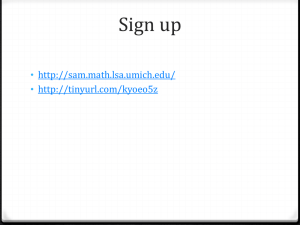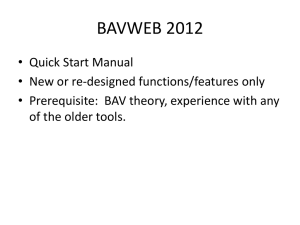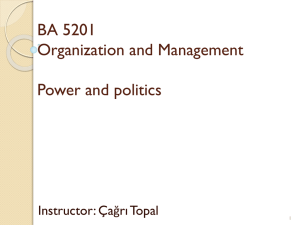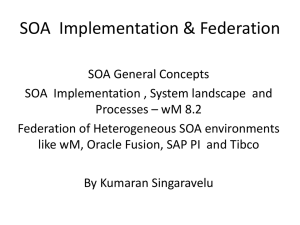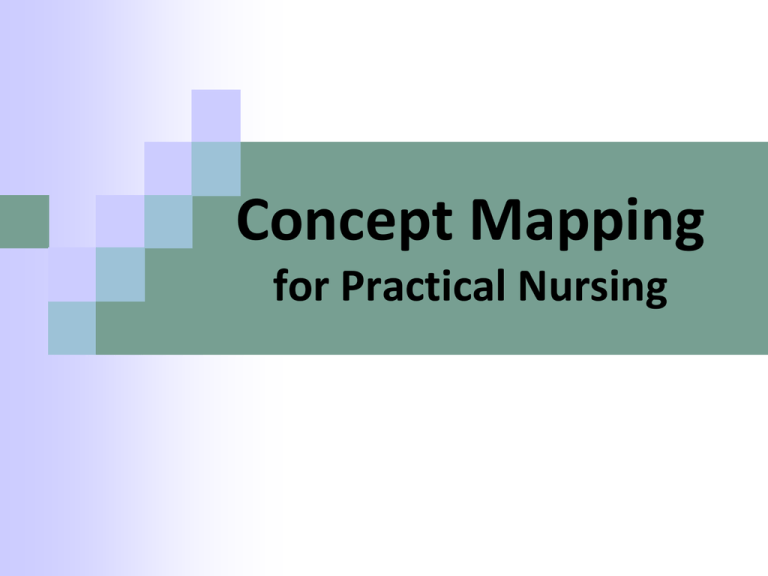
Concept Mapping
for Practical Nursing
Concept Mapping
Goals
Apply care planning with a holistic
view of individual clients
Critically think about
interconnections between data
associated with client problems
Encourage “whole-brain” thinking
What is Concept Mapping?
Visual
representation of your
thinking processes as you plan and
implement nursing care
Use all elements of nursing process
Help you to see “big picture”
What is Concept Mapping?
Interconnect data from various sources
Signs and symptoms/Assessment data
Past medical history
Laboratory and diagnostic data
Medications and medical interventions
Family/Psychosocial data
Getting Started
Use
a large piece of scratch paper then
transfer data to your worksheet(s)
Use pencil on scratch paper
Can be messy at first
Be prepared to do a lot of erasing
Use ink for final copy on worksheet(s)
Construction of a Concept Map
Start
with client
Client is center of map
Map #1: Client Information
Placed
in center of
page
Patient initials
Age
Sex
Medical diagnosis
Admitted from
MJ
74, male
CHF
Admitted - Home
Map #1: Assessment/Data Creating
Clusters
Assess
your client (Be specific)
Document ALL assessment data on front
of your Nursing Worksheet
Review data and underline or highlight
all abnormal data
Group data into data clusters based on
interrelationships of data
Map #1: Assessment/Data Clusters
Review S&S on your diagnosis cards
See how data interrelates
Put similar data into groups
Give each group a simple name
DO NOT use systems
“How do all of these things affect my client?”
Data can be in more than one cluster
Data Clusters
Breathing Problems
Self-Concept
Elimination
Skin
Safety
Activity
Communication
Self Care
Nutrition/Fluid
Cognitive/Perceptual
Map #1: Assessment/Data Clusters
Use as many data clusters as you need
Look at data clusters, does all of this data
relate? Does label fit all data?
Prioritize ALL data clusters. Base this on
theory. Remember Maslow or Peplau.
Pick your top 2 priority data clusters and place
them on concept map
Remember to number them on concept map
Map #1: Assessment/Data Clusters
You
will only list ACTUAL PROBLEMS
Risk problems have a separate area
Number actual problems by priority
Then number risk problems
Data Clusters
Breathing Problems
1 or 2
Fluid
1 or 2
Skin
5
Falls
9
Mobility
6
Nutrition
4
Elimination
7
Communication
10
Self Care
8
Mental status
3
Map #1:
Place top 2 priority data clusters around client
1
SOA with exertion
Unable to walk 12 ft
without resting
O2 sat from 94to 88%
RR from 18 to 24
with activity
O2 at 2L NC
Crackles in bases
2
MJ
74, male
CHF
Home
500cc intake,
250cc output
Crackles in bases
Pitting edema in BLE
HR 100
SOA with exertion
Map #1: Past Health History
Client
may have past health history or
other health problems
Make an additional box for this
information and place on concept map
Map #1:
Past Medical History
2
1
SOA with exertion
Unable to walk 12 ft without resting
O2 sat from 94to 88%
RR from 18 to 24 with activity
O2 at 2L NC
Crackles in bases
MJ
74, male
CHF
Admitted - Home
Type 2 DM
Hypothyroidism
HTN
PVD
BPH
500cc intake, 250cc output
Crackles in bases
Pitting edema in BLE
HR 100
SOA with exertion
Map #2: Risk Problems
Important issues
are on your problem list
that affect care, but are not existing
problems at this time are risk problems
List these, in proper diagnosis format, in
an additional “box” on concept map
Clients will have more than one risk
problem
Map #2:
Risk Problems
1
2
SOA with exertion
Unable to walk 12 ft without resting
O2 sat from 94to 88%
RR from 18 to 24 with activity
O2 at 2L NC
Crackles in bases
500cc intake, 250cc output
Crackles in bases
Pitting edema in BLE
HR 100
SOA with exertion
Type 2 DM
Hypothyroidism
HTN
PVD
BPH
MJ
74, male
CHF
Admitted - Home
Risk for falls
R/T
weakness
and fatigue
Map #2: Nursing Diagnosis
Look at each cluster of assessment data
Pick Nursing Diagnosis that fits data
cluster
Make a new “box” and place it above data
cluster
Place Nursing Diagnosis in box
Nursing Diagnosis ONLY from NANDA list
Add your related to factors (R/T)
Activity intolerance R/T
imbalance
B/W O2 supply and demand
AEB
1
SOA with exertion
Unable to walk 12 ft without resting
O2 sat from 94to 88%
RR from 18 to 24 with activity
O2 at 2L NC
Crackles in bases
Excess Fluid volume R/T
water retention
AEB
MJ
74, male
CHF
Admitted - Home
Type 2 DM
Hypothyroidism
HTN
PVD, BPH
Risk for falls
R/T weakness
and fatigue
2
500cc intake, 250cc output
Crackles in bases
Pitting edema in BLE
HR 100
SOA with exertion
Map #3: Goal/Plan
Add client
goals
Measurable and realistic
What you want to accomplish with your
nursing care/interventions?
It should be the client’ goals, not your
goals
ONE goal for each problem
Activity intolerance R/T
imbalance
B/W O2 supply and demand
AEB
Excess Fluid volume R/T
water retention
AEB
1
SOA with exertion
Unable to walk 12 ft without resting
O2 sat from 94to 88%
RR from 18 to 24 with activity
O2 at 2L NC
Crackles in bases
MJ
74, male
CHF
Admitted - Home
Pt will be able to ambulate 12 feet W/O
resting by ____
2
500cc intake, 250cc output
Crackles in bases
Pitting edema in BLE
HR 100
SOA with exertion
Pt’s lungs will be clear to auscultation
by ________
Type 2 DM
Hypothyroidism
HTN, PVD, BPH
Risk for falls
R/T weakness
and fatigue
Map #4: Interventions
Add nursing interventions for
each
nursing diagnosis
Need AT LEAST 3 nursing interventions
Write as many as you feel are necessary
Make sure at least 1 or 2 are actions
Remember to add anything you are
currently doing
Activity intolerance R/T
imbalance
B/W O2 supply and demand
AEB
Excess Fluid volume R/T
water retention
AEB
1
SOA with exertion
Unable to walk 12 ft without resting
O2 sat from 94to 88%
RR from 18 to 24 with activity
O2 at 2L NC
Crackles in bases
2
MJ
74, male
CHF
Admitted - Home
Pt will be able to ambulate 12 feet W/O
resting by ____
500cc intake, 250cc output
Crackles in bases
Pitting edema in BLE
HR 100
SOA with exertion
Pt’s lungs will be clear to auscultation
by ________
Monitor O2 saturation QS
Assist OOB to chair TID
Provide periods of rest
Type 2 DM
Hypothyroidism
HTN, PVD, BPH
Risk for falls
R/T weakness
and fatigue
Monitor I & O QS
Monitor daily weight
Monitor lung sounds Q4 hr
Encourage C&DB
Map #5: Medications and Labs
Add medications/treatments
Add your laboratory/diagnostic data
Place under nursing diagnosis
which they relate
to
Activity intolerance R/T
imbalance
B/W O2 supply and demand
AEB
Excess Fluid volume R/T
water retention
AEB
1
SOA with exertion
Unable to walk 12 ft without resting
O2 sat from 94to 88%
RR from 18 to 24 with activity
O2 at 2L NC
Crackles in bases
2
MJ
74, male
CHF
Admitted - Home
Pt’s lungs will be clear to auscultation
by ________
Pt will be able to ambulate 12 feet W/O
resting by ____
Monitor O2 saturation QS
Assist OOB to chair TID
Provide periods of rest
Lasix
O2 2l NC
Titrate to Sat>93%
PaCo2 – 50
pH – 7.30
HCO3 – 28
CXR = Effusion
500cc intake, 250cc output
Crackles in bases
Pitting edema in BLE
HR 100
SOA with exertion
Type 2 DM
Hypothyroidism
HTN , PVD, BPH
Risk for falls
R/T weakness
and fatigue
Monitor I & O QS
Monitor daily weight
Monitor lung sounds Q4 hr
Encourage C&DB
Lasix
potassium
BUN – 36mg/dL
Na – 130mEq/L
K – 3.0mmol/L
Map #5: Interconnections
Interconnections are linkages between
problems
These exist in a cause or effect relationship
Begin to look for interconnections
Client is connected to each and every problem
in some way
Help you to see actual connections in a very
concrete manner
Map #5: Interconnections
one problem directly causes another
problem, use a solid arrow from cause
to effect
If one problem indirectly causes
another problem, use a dotted arrow
from cause to effect
Start at client
How does past medical history
interconnect?
If
Activity intolerance R/T
imbalance
B/W O2 supply and demand
Excess Fluid volume R/T
water retention
1
2
SOA with exertion
Unable to walk 12 ft without resting
O2 sat from 94to 88%
RR from 18 to 24 with activity
O2 at 2L NC
Crackles in bases
MJ
74, male
CHF
Admitted - Home
Pt will be able to ambulate 12 feet W/O
Resting by ____
Pt will maintain a Sat >93% by ___
Monitor O2 saturation QS
Assist OOB to chair TID
Provide periods of rest
Lasix
O2 2l NC
Titrate to Sat>93%
PaCo2 – 50
pH – 7.30
HCO3 – 28
CXR = Effusion
500cc intake, 250cc output
Crackles in bases
Pitting edema in BLE
HR 100
SOA with exertion
Pt output will equal intake by___
Pt’s lungs will be clear to auscultation
By ________
Type 2 DM
Hypothyroidism
HTN, PVD, BPH
Risk for Falls R/T
weakness & fatigue
Monitor I & O QS
Monitor daily weight
Monitor lung sounds Q4 hr
Lasix
potassium
BUN – 36mg/dL
Na – 130mEq/L
K – 3.0mmol/L
Evaluation
If
you have opportunity to care for client
a second day, you may evaluate if plan of
care has worked for any short term goal
It is good to practice evaluation, discuss
in post-conference
Please Feel
Free To Be
Creative
You can write them, type them,
use colors, or highlighter
Use different shaped boxes
You must keep basic
components
Presentation is up to you
Past Health
History
High Risk
Problems
1
2
ND
RT
ND
RT
AEB
Goals
AEB
Meds
Treatments
Goals
Meds
Treatments
PMH
ND
1
RT
AEB
Meds
2
ND
RT
AEB
Risk Problems
Meds
Nursing Diagnosis
Meds
AEB
Goals
Treatments
Concept Mapping in Long Term Care
Your concept map in long term care will look
very different from your concept map in acute
care
In acute care, we focus on actual problems
that require immediate intervention to
correct client’s problems
In long term care, we focus on actual
problems that require maintenance in order
to prevent further decline in condition
Impaired mobility R/T neurological
impairment
2
ROM (R arm contracture)
Strength (able to resist force with
L leg only)
Sara Lift to transfer
Resident will maintain ability to bear wt.
on LLeg and transfer with Sara Lift with
every transfer, ongoing
1. Perform
ROM exercises to each extremity
2. Use Sara Lift to transfer OOB and to
reposition q 2hr
3. Assess need for pain
medication prior to transfer
Risk for Falls R/T
decreased ROM and strength
Impaired Swallowing R/T
Neurological Impairment
MJ
74, male
CVA
Admitted - Home
1
Coughing and choking when eating
History of aspiration pneumonia
Pocketing food
Thickened liquids
Resident will swallow without coughing
or choking with all intake, ongoing.
Pt will maintain clear lungs to
auscultation, ongoing
Type 2 DM
Hyperlipidemia
HTN , CAD,
Pneumonia
1. Position resident upright at 90 degree
angle/head flexed 45 degrees for
all feedings
2. Place food on unaffected side of tongue.
3. Cue resident during feeding
WBC 18,000
CXR Infiltrates
Augmentin

